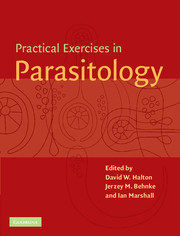Book contents
- Frontmatter
- Contents
- List of contributors
- Preface
- General advice
- 1 Observational Exercises on Parasites
- A Local wild and domestic hosts as sources of parasites
- B Laboratory maintained species
- 1.8 Protozoan parasites of the intestinal tract of the cockroach, Periplaneta americana
- 1.9 Protozoan parasites of the mouse intestinal tract
- 1.10 Rodent malaria
- 1.11 Malaria: an example of a vector transmitted parasite
- 1.12 Larval and adult Echinostoma spp. (Trematoda)
- 1.13 Schistosoma mansoni (Trematoda)
- 1.14 Hymenolepis diminuta (Cestoda)
- 1.15 Heligmosomoides polygyrus (Nematoda)
- 2 Ecology
- 3 Physiology and Biochemistry
- 4 Pathology and Immunology
- 5 Chemotherapy
- 6 Molecular Parasitology
- 7 Behaviour
- Appendix 1 Reagent index
- Appendix 2 UK suppliers
- Appendix 3 US suppliers
- Index
1.11 - Malaria: an example of a vector transmitted parasite
Published online by Cambridge University Press: 05 June 2012
- Frontmatter
- Contents
- List of contributors
- Preface
- General advice
- 1 Observational Exercises on Parasites
- A Local wild and domestic hosts as sources of parasites
- B Laboratory maintained species
- 1.8 Protozoan parasites of the intestinal tract of the cockroach, Periplaneta americana
- 1.9 Protozoan parasites of the mouse intestinal tract
- 1.10 Rodent malaria
- 1.11 Malaria: an example of a vector transmitted parasite
- 1.12 Larval and adult Echinostoma spp. (Trematoda)
- 1.13 Schistosoma mansoni (Trematoda)
- 1.14 Hymenolepis diminuta (Cestoda)
- 1.15 Heligmosomoides polygyrus (Nematoda)
- 2 Ecology
- 3 Physiology and Biochemistry
- 4 Pathology and Immunology
- 5 Chemotherapy
- 6 Molecular Parasitology
- 7 Behaviour
- Appendix 1 Reagent index
- Appendix 2 UK suppliers
- Appendix 3 US suppliers
- Index
Summary
Aims and objectives
This exercise is designed to demonstrate:
The different stages in the life cycle of Plasmodium spp.
How to recognise infection in a mammal and a mosquito.
Introduction
Over 40% of the world's population live at risk from infection with malaria, a parasitic protozoan of the genus Plasmodium. The malaria parasite is transmitted by its mosquito vector that feeds on blood. The typical symptoms of malaria include short episodes of severe fever, occurring every two or three days, anaemia and enlargement of the spleen. Between 300–500 million clinical cases of malaria occur each year and 1.5–2.7 million people die of the disease annually. Ninety percent of cases are in tropical Africa and half of the deaths are in children under five years. A more detailed account of malaria can be found in Knell (1991).
The life cycle of the malaria parasite (Fig. 1.11.1) has four phases: three asexual and one sexual. Sporozoites from the mosquito are injected into the blood and immediately invade the liver. Here they become trophozoites and grow and multiply to form schizonts containing many merozoites (asexual phase 1). When the liver cells burst, merozoites are released into the blood and invade red blood cells. Erythrocytic trophozoites grow and divide to form schizonts containing new merozoites. These are released when the infected red cell bursts and they invade new red cells (asexual phase 2).
- Type
- Chapter
- Information
- Practical Exercises in Parasitology , pp. 89 - 96Publisher: Cambridge University PressPrint publication year: 2001



